As most Tennessee soybeans are entering their mid-late reproduction growth stages, some symptoms of diseases caused by soil-borne pathogens may be beginning to show up in our fields, particularly sudden death syndrome this year. The issue with diagnosing diseases caused by soil-borne pathogens is that they often exhibit very similar symptomology to each other. However, there are certain indicators that can help you differentiate between these diseases and help you make the best management decisions moving forward.
- Sudden Death Syndrome (causal pathogen: Fusarium virguliforme)
Sudden Death Syndrome (SDS) is caused by a fungal pathogen and can result in rotting of the root tissues. However, the most common symptom of SDS is interveinal chlorosis (yellowing) of the leaves, which is caused by a toxin that the fungus produces. Yellowing tissue may eventually turn brown as it begins to die, and at this point the leaves may defoliate prematurely. A key characteristic of SDS is that after defoliation, the petioles will remain attached to the plant. In comparison to stem canker, when the stem of the plant is split, the inner vascular tissue will not be discolored, only the outer tissue will begin to turn brown as the infection progresses. SDS development risk is greatest when planting in April, after corn, under irrigation in a high yield potential field with a susceptible variety. This year the good growing weather Tennessee has had has also promoted more SDS than usual. Although, phytotoxicity from chemical (burn/yellowing) has also been seen this year – with chemical injury entire fields will show similar symptoms uniformly and the newest leaves will be unaffected (those that develop after the chemical application).
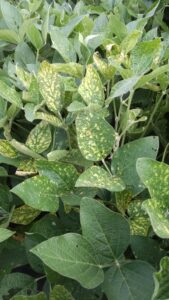
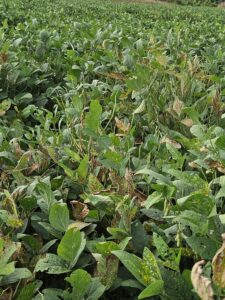
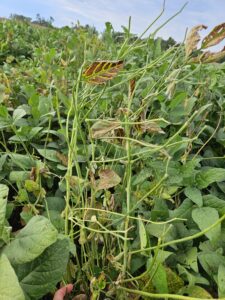
- Southern Stem Canker (causal pathogen: Diaporthe phaseolorum var. meridionalis)
Similar interveinal chlorosis (yellowing) of leaves occurs, but also with brown spots on the stem near the bottom nodes of the canopy will grow together to develop a canker that is several inches in length, and this canker will only be seen on one side of the stem. Upon splitting the stem open, the center pith of the plant will be brown, although if Dectes stem borer had been in the plant the center pith will also be brown from the insect damage. The leaves exhibiting interveinal yellowing will eventually die, but in contrast to SDS, after the leaves die, they will remain attached to the petioles on the plant.
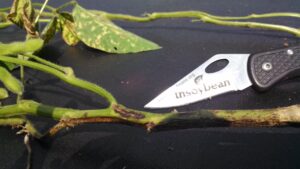
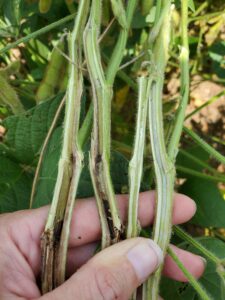
- Charcoal Rot (causal pathogen: Macrophomina phaseolina)
Charcoal rot is typically seen in very hot and dry growing seasons. This disease causes an overall loss of vigor and decreased leaflet size. Similarly to southern stem canker, the leaves will also begin to turn yellow, die, and then remain attached to the plant via the petiole. When examining the inside of the root, and sometimes even the outside of the lower stem, small black structures called microsclerotia may be visible.
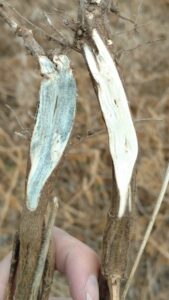
- Taproot Decline (causal pathogen: Xylaria necrophora)
Taproot Decline (TRD) is an emerging disease in Tennessee. Discovered for the first time in 2017, TRD has only been reported in 4 counties so far (Fayette, Madison, Gibson, and Haywood). Similarly, to all of the aforementioned diseases, TRD also causes interveinal yellowing of the leaves. This yellowing will begin in the lower canopy and work its way up the canopy as the season progresses. Yellowing tissue will turn brown as the leaves begin to roll up and die, and the whole plant will also begin to shrivel and die. Symptomatic plants during reproductive growth stages will have plants next to them that died prematurely. When pulling the soybean out of the ground, plants afflicted with TRD will often snap off at the soil-line. When splitting open the root tissues, the pith will always have white fungal growth in it and browning of the vascular tissue. Also, when looking at the soil line next to symptomatic plants, stromata (the reproductive structure of the fungal pathogen) may be found on left over crop debris. Watch this short video on TRD to learn more and view more identifying features( Soybean Taproot Decline: An Emerging Disease – YouTube).

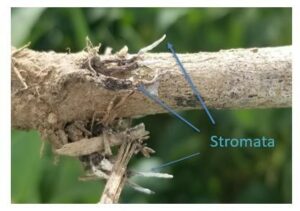
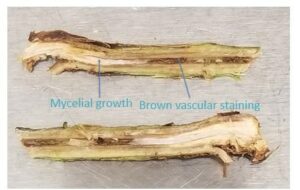
- Phytotoxicity (from chemical injury)
Yellowing of leaves can also be from chemical injury/burn. This is apparent when the entire yield is uniformly affect and the newest growth on the plants are not exhibiting the same yellowing symptom (i.e. the newest growth is clean and green). Be mindful you can have more than one issue going on in the field (e.g. phytotoxicity and some sudden death syndrome).
Now that you know the key indicators of how to tell some of these common soil-borne soybean diseases apart, you may be wondering about management. Although these diseases are caused by pathogens in the soil very early in the season, we often do not see the symptoms until later in the season, usually during reproductive growth stages. At this point, it is too late to manage it for the current season, but correctly identifying and recording the present of the disease is key for future management. Prevention practices are key in combating soil-borne pathogens including resistant varieties, crop rotation, and planting dates. To find more specifics on management strategies and/or specifics on variety selection you can visit our field guides at guide.utcrops.com.

